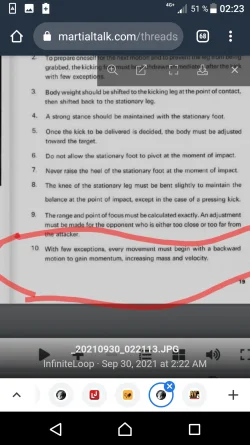InfiniteLoop
Black Belt
And bending the knee does not increase mass and velocity...
There will only be an increased acceleration if the entire body part moves back and then forward.... Such as if you throw a haymaker punch and move the entire arm back and then forward.
But of course, you aren't supposed to do that since it telegraphs the motion.
The mass being increased by chambering is also rubbish. Mass is decreased since chambering halts the progressive travel time of the leg and then releases it again.
There will only be an increased acceleration if the entire body part moves back and then forward.... Such as if you throw a haymaker punch and move the entire arm back and then forward.
But of course, you aren't supposed to do that since it telegraphs the motion.
The mass being increased by chambering is also rubbish. Mass is decreased since chambering halts the progressive travel time of the leg and then releases it again.
Last edited:

